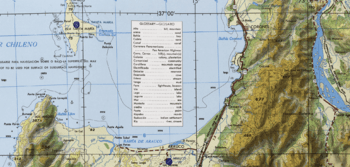Santa María Island, Chile facts for kids
|
Native name:
Santa María
|
|
|---|---|

Gulf of Arauco, Chile
|
|
| Geography | |
| Location | East Pacific Ocean |
| Total islands | 3 |
| Major islands | 1 |
| Area | 35 km2 (14 sq mi) |
| Administration | |
|
Chile
|
|
| Regions of Chile | Bío Bío Region |
| Communes of Chile | Coronel, Chile |
| Largest settlement | Puerto Sur |
| Demographics | |
| Population | 2200 |
Santa María Island is a quiet island off the coast of Coronel in Chile. Not many people live there, but it has been part of many important moments in history. This island is located in the Pacific Ocean and is a fascinating place to learn about.
Contents
Island History: Key Events and Discoveries
Early Names and European Discovery
Before Europeans arrived, the Mapuche people lived on Santa María Island. They called it Tralca or Penequen. The first European to likely see the island was Juan Bautista Pastene. He spotted it in 1544 or 1550 during his travels.
Pirate Visits and Raids
Santa María Island became a stop for many famous pirates. In 1586, the English pirate Thomas Cavendish attacked and robbed places on the island. This happened during his first trip around the world.
Later, Dutch pirates also visited the island. Joris van Spilbergen, Simon de Cordes, and Hendrik Brouwer all anchored there. They would stop to get fresh water and wood for their ships.
Dutch Plans in Chile
In 1642, two Dutch trading companies, the Dutch East India Company and the Dutch West Indies Company, planned an expedition. They wanted to set up a trading base on the west coast of South America. They considered Valdivia, Chiloé Island, and Santa María Island. These places were good because they had harbors and were somewhat separate from Spanish control in Chile.
Valdivia had been abandoned by the Spanish in 1599. The Mapuche people had destroyed many cities south of the Bío Bío River during a conflict called the Destruction of the Seven Cities.
Brouwer's Expedition and Valdivia
The Dutch fleet sailed from Dutch Brazil. John Maurice of Nassau helped them with supplies. After landing on Chiloe Island, Hendrik Brouwer made a deal with the Mapuche. The Mapuche were often fighting against Spain in the War of Arauco. They agreed to help the Dutch settle in Valdivia.
Sadly, Hendrik Brouwer died on August 7, 1643, before reaching Valdivia. His second-in-command, Elias Herckman, took over. Herckman landed at the ruins of Valdivia on August 24. He named the new settlement Brouwershaven in honor of Brouwer. Brouwer was buried there.
Herckman and his men stayed in Valdivia only until October 28, 1643. The Spanish heard that the Dutch might return. So, in 1644, the Spanish viceroy in Peru sent 1000 soldiers in twenty ships to Valdivia. They wanted to resettle and fortify the area. The Spanish soldiers dug up Brouwer's body and burned it.
Spanish Actions to Protect the Island
To stop pirates from using Santa María Island, the Spanish took action. They destroyed and burned buildings on the island. This made it less useful for pirates seeking shelter or supplies.
On October 26, 1818, the First Chilean Navy Squadron arrived at the island. It was led by Manuel Blanco Encalada. They captured several Spanish ships that were carrying soldiers and weapons. These Spanish ships were headed for El Callao.
A famous naval battle, the Battle of Coronel, happened near Santa María Island. This battle took place on November 1, 1914. During this fight, the British ship HMS Good Hope sank. Everyone on board was lost. This happened about 10 miles west of the island.
On April 22, 1924, a sailing ship called the SV Garthwray ran aground on Santa María Island. This happened during a fog. The Garthwray was known for losing its masts in storms near Cape Horn in 1922 and 1923.
Geological Changes: The 2010 Earthquake
The 2010 Chile earthquake was a very powerful natural event. It caused the island to rise by 1.8 meters (about 6 feet). This shows how strong earthquakes can change the land.
Island Wildlife and Nature
Marine Animals Around Santa María Island
The South American sea lion is one of the interesting animals you can find along the coast of Santa María Island. These large marine mammals often rest and play on the island's shores.
Santa María Island in Literature
The Island in Benito Cereno
Santa María Island is the setting for a famous novel by Herman Melville. His book, Benito Cereno, takes place on this very island. It's a story about a ship and its mysterious captain.
See also
 In Spanish: Isla Santa María (Chile) para niños
In Spanish: Isla Santa María (Chile) para niños


